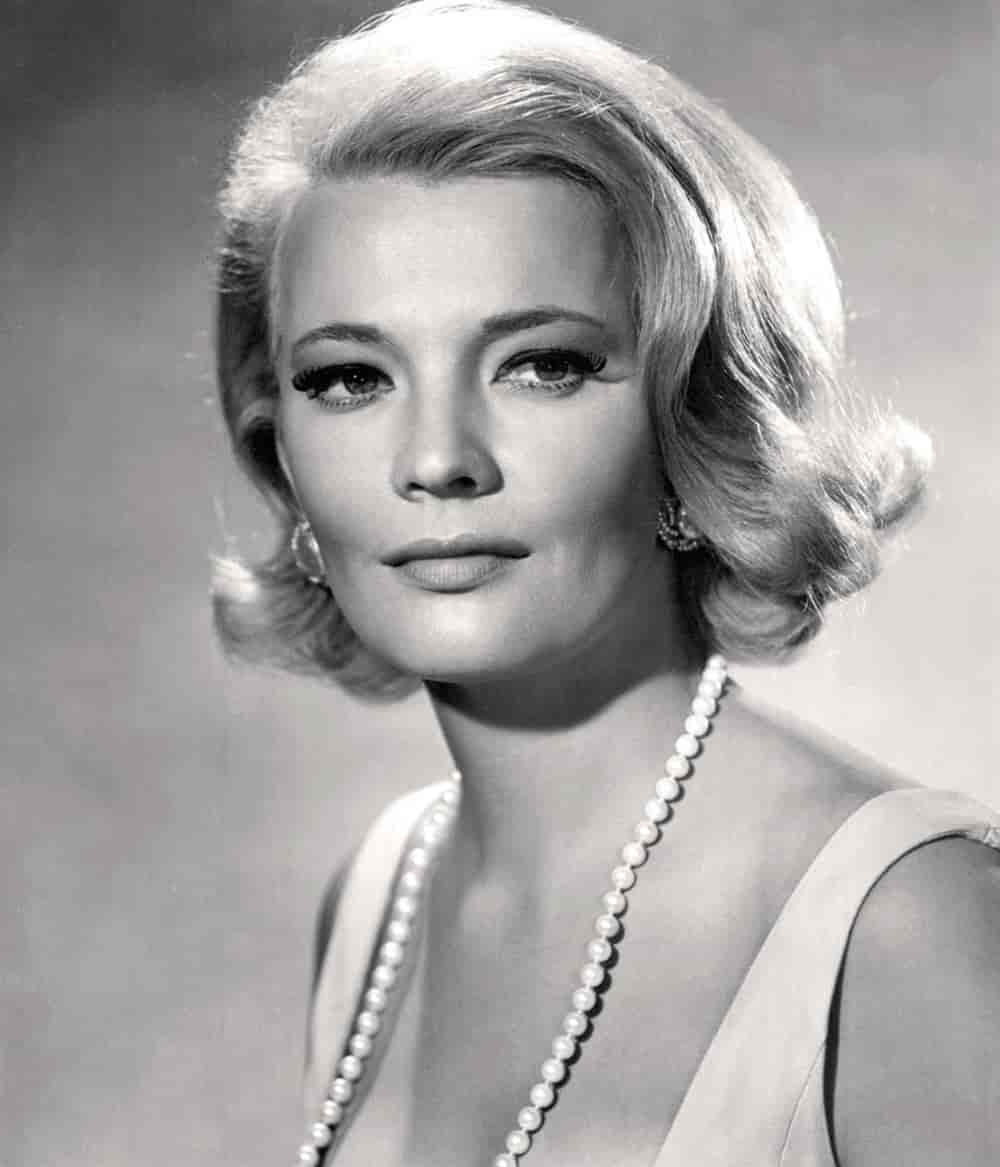
Gena Rowlands, whose unvarnished acting abilities placed her in the pantheon of acting legends and who became synonymous with the American independent film movement through her collaborations with her husband, the director John Cassavetes, died on Wednesday. She was 94.
Rowlands died at her home in Indian Wells, California, surrounded by family members. TMZ was the first to report the news, which was subsequently confirmed by a spokesperson for WME, where her son, the writer – director Nick Cassavetes, is represented. She had been battling Alzheimer’s since 2019.
Rowlands was hailed as one of the greatest actors to have ever practiced the craft. She was the wife and muse of John Cassavetes, appearing in many of his groundbreaking films, including Faces, A Woman Under the Influence, Opening Night, and Gloria. Operating outside the traditional studio system, the couple created indelible portraits of working – class strivers and small – timers, shaping the landscape of American cinema.
Virginia Cathryn Rowlands was born on June 19, 1930, in Madison, Wisconsin. She grew up in Cambria, Wisconsin, where her Welsh ancestors had settled. Her father was a banker and a state senator, while her mother had been invited to be a Ziegfeld girl but chose to pursue a career in art instead.
As a child, she was withdrawn but loved books and make – believe. Her mother encouraged her ambition of becoming an actor. The family moved due to her father’s political appointments, first to Washington, D.C., and later to Minneapolis.
Rowlands returned to her native state as a young adult and attended the University of Wisconsin. However, she left in her junior year to pursue acting in New York and studied at the American Academy of Dramatic Arts. It was there that she encountered John Cassavetes, an alumnus a year ahead of her.
Cassavetes spotted Rowlands in a student production of J.B. Priestley’s Dangerous Corner in either 1953 or 1954. Their connection was immediate; they married just four months after meeting, in 1954. They remained together until his death from cirrhosis in February 1989, at the age of 59.

Rowlands’ first professional stage appearance took place in a drama at the Provincetown Playhouse. She also gained experience in the burgeoning field of live television drama in the 1950s, appearing on many major series. Her big break arrived in 1956 when producer – director Joshua Logan cast her opposite Edward G. Robinson in Paddy Chayefsky’s play Middle of the Night. Playing the role of a young woman who falls in love with her much older boss, she garnered reviews that hailed her as a new star.
After spending 18 months with the play, Rowlands signed a contract with MGM, agreeing to appear in two pictures a year. Her feature debut came in the drama The High Cost of Loving (1958), in which she played Jose Ferrer’s confident wife. Her performance led to comparisons to one of the great stars of the 1930s, Carole Lombard.
She later asked to be released from her MGM contract because she was expecting a baby. Throughout her career, she would often absent herself from the screen for considerable periods to attend to family matters. She and Cassavetes had three children: Nick, Alexandra, and Zoe, all of whom would go on to become actor – directors.
After leaving MGM, she had the freedom to choose her film roles. When suitable roles were not available, she appeared in popular television series of the time, including Alfred Hitchcock Presents, Bonanza, Dr. Kildare, and The Virginian. In the 1960s on television, she took on distinct roles, such as playing the deaf – mute wife of a detective on the NBC series 87th Precinct and portraying the temptress Adrienne Van Leyden on ABC’s Peyton Place.
She also performed in films by other directors, including the Dalton Trumbo Western Lonely Are the Brave (1962) with Kirk Douglas, The Spiral Road (1962) opposite Rock Hudson, and Tony Rome (1967) with Frank Sinatra.
The partnership with John Cassavetes was foundational to her legacy. Their journey in independent filmmaking began after Cassavetes’ experience with producer Stanley Kramer on A Child Is Waiting (1963), in which Rowlands had a small role. This clash with the Hollywood system solidified their decision to work independently.
Cassavetes had previously used his earnings from the TV series Johnny Staccato (in which Rowlands also guest – starred) to finance his first film, Shadows (1959), a landmark of the American new wave, although Rowlands did not appear in it. Their true breakthrough working together came with Faces in 1968.
In Faces, a film exploring the disintegration of a marriage, Rowlands played the role of a caring professional escort. This film, like many of their subsequent collaborations, explored the depths of human emotion through raw, naturalistic performances.

Rowlands made a total of 10 films with Cassavetes over four decades. These included Minnie and Moskowitz (1971), in which she portrayed an art gallery curator recovering from a breakup who encounters an eccentric suitor. She was also wonderful in the screwball comedy Love Streams (1984), their final collaboration, in which she played the sister of an alcoholic, portrayed by Cassavetes himself.
Their approach to filmmaking was driven by a desire for autonomy. “We wanted a certain way of life,” she once said. “We wanted to get up and really do what we wanted to do that day. We didn’t want to do something that everyone said we should do.” This path was challenging; “Believe me, everyone was saying we were doing the wrong thing all the time. But it was terribly satisfying.”
Funding their independent projects required significant effort. “It was impossible to raise money outside the studio,” she told The Guardian in 2001. They often financed the films themselves. “We totally financed all the films ourselves except for A Woman Under the Influence, for which Peter Falk and his wife paid half.” She added that being established actors provided a crucial lifeline: “But we were luckier than a lot of young directors now because we were both established actors, and when we ran out of money, which was all the time, we would stop and each make a movie.”
The independent lifestyle also permeated their home life. “I think of the kids too,” she recalled. “Every time they stepped out of their bedrooms, they were tripping over a cable or bumping into a camera. They were very at ease with it. It wasn’t some kind of exotic thing where your parents went to the studio; they didn’t feel left out of it.”

Cassavetes often wrote his films with Rowlands in mind. He was deeply interested in portraying the experiences of women. As she told THR’s Scott Feinberg in 2015, her husband “loved actors, and he had a particular interest in women. I should say, women in movies! He was interested in women’s problems, their position in society, and what they had to overcome. He offered me some really wonderful roles.” She echoed this sentiment to the AP in 2015, stating, “He had a particular sympathetic interest in women and their problems in society, how they were treated, and how they solved and overcame the challenges they faced, so all his movies feature some interesting women, and you don’t need many.”
Her performances in Cassavetes’ films were noted for their depth and authenticity. Cassavetes himself commented on her unique approach in Ray Carney’s 2001 book Cassavetes on Cassavetes. He noted that Rowlands “sets the initial premise and follows the script very closely. Very rarely will she improvise, though she does so in her mind and in her personal thoughts. Everybody else is going boom! boom! boom!, but Gena is very dedicated and pure.”
He added that she was singularly focused on the truth of the performance. “She doesn’t care if it’s cinematic, doesn’t care where the camera is, doesn’t care if she looks good — doesn’t care about anything except that you believe her,” he said. Commenting on her role in Gloria, he observed, “She captured the rhythm of that woman living a life she’d never seen. When she’s ready to kill, I’m amazed at how coldly she carries it out.”
Two of her collaborations with Cassavetes earned her Academy Award nominations for Best Actress. The first was for her tour-de-force performance as Mabel Longhetti in A Woman Under the Influence (1974), in which she played an isolated, emotionally vulnerable housewife who lapses into madness and is institutionalized. Describing the character, she noted that the housewife “was totally vulnerable and giving; she had no sense of her own worth.”
Recounting a moment during the filming of the first scene in A Woman Under the Influence, Rowlands shared a piece of direction from Cassavetes that she found incredibly liberating. She asked him a question, something she noted she usually did not do, saying, “I am sort of stuck.” His response was direct: “Gena, before you go any further, I wrote the picture with you in mind. You said you liked it.” “I said I loved it.” “He said, ‘You said you wanted to do it.’” “I said, ‘I do.’” “And he said, ‘Then do it.’”
Rowlands indicated that this unfiltered response “was the most liberating, wonderful piece of advice. You didn’t have to depend on anybody or anything anybody said. It was yours to do with as you saw fit. It was like someone gave you a gift.” She lost the Oscar that year to Ellen Burstyn for Alice Doesn’t Live Here Anymore.
Her second Oscar nomination came for Gloria (1980), in which she displayed startling resilience as Gloria Swenson, a former girlfriend of a mobster who goes on the run to protect the young boy (John Adames) who lives next door. Despite its action-packed nature, she considered it a “gangster comedy.” In Cassavetes on Cassavetes, John said he agreed to make the film because Rowlands wanted to play a role capturing how she sometimes saw herself — the “sexy but tough woman who doesn’t really need a man” type, like one of her idols, Marlene Dietrich. She lost this nomination to Sissy Spacek for Coal Miner’s Daughter.
Her greatness was formally acknowledged by the Academy later in her career. She received an honorary Oscar at the 2015 Governors Awards. At the ceremony, she spoke eloquently about her chosen profession, stating, “You know what’s wonderful about being an actress? You don’t just live one life — yours — you live many lives.”
In her speech, she also paid tribute to the often-unsung heroes of the craft, the writers. “For that,” she continued, in words that resonate given recent industry events, “we have to thank the writers. After all, they’re the ones who start out with a piece of blank paper and create the story and the characters, and that gives us actors the opportunity to hopefully bring all those characters to life.”
Beyond her work with Cassavetes and her Oscar nominations, Rowlands accumulated numerous accolades. She won two Golden Globe Awards, including one for starring as the first lady in the 1987 TV movie The Betty Ford Story. Her extensive television work also garnered her a total of four Emmy Awards from eight nominations, with another Emmy win for portraying a waitress romanced by another Cassavetes regular, Ben Gazzara, in 2002’s Hysterical Blindness. She also received one Daytime Emmy Award during her career.
Even when playing beleaguered heroines, Rowlands often downplayed her corn-fed Midwestern beauty, subverting her good looks when the part demanded, as in Opening Night (1977), in which she portrayed the aging and insecure stage actress Myrtle Gordon, a role depicting a mentally ill theater actress.
After John Cassavetes’ death in 1989, Rowlands continued to act, in part to assuage her grief. Her career spanned Broadway, film, and television over half a century, during which she appeared in more than 40 movies and an even greater number of television shows. She continued to undertake diverse and challenging roles.
She collaborated with her son Nick Cassavetes on several films. She starred as a lonely widow for him in Unhook the Stars (1996) and appeared in She’s So Lovely (1997), which was based on a script by John Cassavetes. A new generation of audiences was introduced to her work through her role in Nick’s blockbuster The Notebook (2004), in which she played the older version of Rachel McAdams’ character, Allie, an elderly woman with dementia. Nick Cassavetes revealed in June 2024 that his mother had been suffering from Alzheimer’s for the past five years, living with full – blown dementia, mirroring the character she portrayed.
Rowlands also appeared in her daughter Zoe Cassavetes’ directorial debut, Broken English (2007), alongside Parker Posey. Her other daughter, Alexandra Cassavetes, is also a writer and director.
Throughout her later career, Rowlands explored roles with a variety of directors. She played the mother of Michael J. Fox and Joan Jett in Paul Schrader’s 1987 study of a blue – collar family, Light of Day. In Woody Allen’s austere drama Another Woman (1988), she was cast as a philosophy professor in crisis, whose life had been shielded from emotions until dire incidents forced her to confront her feelings.

Her film appearances after Cassavetes’ death included Jim Jarmusch’s Night on Earth (1991), the first film she made after her husband’s passing, in which she played a cab passenger. She also appeared in Lasse Hallström’s Once Around (1991), Something to Talk About (1995), Terence Davies’ 1995 adaptation of The Neon Bible, Hope Floats (1998), The Skeleton Key (2005), and Six Dance Lessons in Six Weeks (2014), her last film appearance, in which she played a retiree who befriends her gay dance instructor.
She also worked with Bette Davis, an actress she idolized, in the 1979 telefilm Strangers: The Story of a Mother and Daughter. Rowlands, then nearly 50, played Davis’ daughter. During her honorary Oscar speech, Rowlands recounted an anecdote from the production, in which she and Davis watched film snippets from the previous day’s shoot. While Rowlands was satisfied with her performance, Davis was furious, poking her finger at the cameraman because her lips appeared orange on film.
Davis suddenly called Rowlands over and asked if she noticed the same thing. Rowlands, deflecting, simply said she hadn’t been paying close attention. According to Rowlands, Davis’ sharp reply amid laughter was, “Huh, you weren’t paying attention? Well, you better start paying attention, because let me tell you something, you’re no spring chicken yourself.”
Her roles remained with her long after filming ended. “Sometimes, on those sleepless white nights when I have a lot of time to think about everything, I’ll examine different possibilities of different characters and what they might be doing now,” she said. Reflecting on her career, she noted in a 2015 short film for the Academy titled “What Acting Means to Me” that “acting is very much like reading a book, and as I read, I began to realize that as an actor you could be a lot of people and a lot of things, and it caught my fancy.” She also appeared as part of a lesbian couple raising three children in a 1983 Hallmark production of Thursday’s Child.
Throughout her career, she took roles in other people’s movies, such as Machine Gun McCain (1969), Two-Minute Warning (1976), and Paul Mazursky’s Tempest (1982), in which she acted alongside John Cassavetes, to support their own independent productions.
She attended film festivals and societies for Cassavetes screenings after his death. In 1992, at the San Sebastian Festival, she said, “I want everyone to see his films.” She reflected on her late husband, “John was one of a kind, the most totally fearless person I’ve ever known. He had a very specific view of life and the individuality of people.”
Critics and peers alike recognized her extraordinary talent. Tennessee Williams once compared Rowlands to a work of art that “you place yourself in front of as if they were paintings in a museum, or sunsets, or mountains, or lovers walking slowly away from you.” Director Sidney Lumet offered a profound tribute, stating, “The highest compliment I can pay to her — to anyone — is that her talent frightens me, making me aware of the lack of it in so many and the power that accrues to those who have it and use it well. And her talent educates and illuminates. She is admirable, which can be said of only a few of us.”
Read more about: The Evolution of Eyebrow Trends: A Journey Through Decades of Beauty Evolution

Rowlands retired from the profession in 2015. Since 2012, she had been married to her second husband, retired businessman Bob Forrest, who survives her along with her children Nick, Alexandra, and Zoe Cassavetes.
Gena Rowlands was one of the last of Hollywood’s living legends, a fearless and dedicated artist whose powerful performances, particularly those forged in collaboration with John Cassavetes, left an indelible mark on cinema. Her work, characterized by raw emotion and a profound commitment to character, continues to resonate, serving as a testament to a life spent inhabiting many others and enriching our understanding of the human experience on screen.




